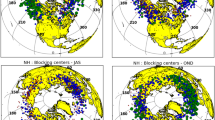Abstract
In this study, the temporal structure of the variation of North Atlantic Oscillation (NAO) and its impact on regional climate variability are analyzed using various datasets. The results show that blocking formations in the Atlantic region are sensitive to the phase of the NAO. Sixty-seven percent more winter blocking days are observed during the negative phase compared to the positive phase of the NAO. The average length of blocking during the negative phase is about 11 days, which is nearly twice as long as the 6-day length observed during the positive phase of the NAO. The NAO-related differences in blocking frequency and persistence are associated with changes in the distribution of the surface air temperature anomaly, which, to a large extent, is determined by the phase of the NAO. The distribution of regional cloud amount is also sensitive to the phase of the NAO. For the negative phase, the cloud amounts are significant, positive anomalies in the convective zone in the Tropics and much less cloudiness in the mid latitudes. But for the positive phase of the NAO, the cloud amount is much higher in the mid-latitude storm track region. In the whole Atlantic region, the cloud amount shows a decrease with the increase of surface air temperature. These results suggest that there may be a negative feedback between the cloud amount and the surface air temperature in the Atlantic region.
Similar content being viewed by others
References
Barnett, T. P., 1985: Variations in near-global sea level pressure. J. Atmos. Sci.,42, 478–501.
Barnston, A. G., and R. E. Livezey, 1987: Classification, seasonality and persistence of low-frequency atmospheric circulation patterns. Mon. Wea. Rev., 115, 1083–1126.
Cayan, D. R., 1992: Latent and sensible heat flux anomalies over the northern oceans: The connection to monthly atmospheric circulation. J. Climate, 5, 354–369.
Charney, J., and J. DeVore, 1979: Multiple flow equilibria in the atmosphere and blocking. J. Atmos. Sci., 36, 1205–1216.
Cook, E. R., R. D. D’Arrigo, and K. R. Briffa, 1998: A reconstruction of the North Atlantic Oscillation using tree-ring chronologies from North America and Europe. The Holocene, 8, 9–17.
Del Genio, A. D., A. A. Lacis, and R. A. Ruedy, 1991: Simulation of the effect of a warmer climate on atmospheric humidity. Nature, 351, 382–385.
Ding, S., G. Shi, and C. Zhao, 2004: Analyzing global trends of different cloud types and their potential impacts on climate by using the ISCCP D2 dataset. Chinese Science Bulletin, 49, 1301–1306.
Dole, R. M., 1989: Life cycles of persistent anomalies. Part I: Evolution of 500 mb height field. Mon. Wea. Rev., 117, 177–211.
Huang, J., K. Higuchi, and N. B. A. Trivett, 1997: Multiresolution Fourier transform and its application on analysis of CO2 fluctuations over Alert. J. Meteor. Soc. Japan, 75, 701–715.
Huang, J.-P., K. Higuchi, and A. Shabbar, 1998: The relationship between the North Atlantic Oscillation and El Niño-Southern Oscillation. Geophys. Res. Lett., 25, 2707–2710.
Hurrell, J. W., 1995: Decadal trends in the North Atlantic Oscillation: Regional temperatures and precipitation. Science, 269, 676–679.
Hurrell, J. W., 1996: Influence of variations in extratropical wintertime teleconnections on Northern Hemisphere temperature. Geophys. Res. Lett., 23, 665–668.
Hurrell, J. W., and H. van Loon, 1997: Decadal variations in climate associated with the North Atlantic Oscillation. Climate Change, 36, 301–326.
Kalnay, E., and Coauthors, 1996: The NCEP/NCAR 40-year reanalysis project. Bull. Amer. Meteor. Soc., 77, 437–471.
Knox, J. L., and J. E. Hays, 1985: Blocking signatures in the Northern Hemisphere: Frequency distribution and interpretation. J. Climatol., 5, 1–16.
Li, J., and Julian X. L. Wang, 2003: A new North Atlantic Oscillation index and its variability. Adv. Atmos. Sci., 20, 661–671.
Lindzen, R. S., M.-D. Chou, and A. Y. Hou, 2001: Does the earth have an adaptive infrared iris? Bull. Amer. Meteor. Soc., 82, 417–432.
Nesterov, E. S., 1998: Characteristic features of ocean and atmosphere in different phases of the North Atlantic Oscillation. Russian Meteorology and Hydrology, 8, 58–65.
Rogers, J. C., 1984: The association between the North Atlantic Oscillation and the Southern Oscillation in the Northern Hemisphere. Mon. Wea. Rev., 112, 1999–2015.
Shabbar, A., J. Huang, K. Higuchi, 2001: The relationship between the wintertime North Atlantic Oscillation and blocking episodes in the North Atlantic. International Journal of Climate, 21 (3), 355–369.
Schneider, U., and C.-D. Schonwiese, 1989: Some statistical characteristics of the El Niño/Southern Oscillation and North Atlantic Oscillation indices. Atmosfera, 2, 167–180.
Stockwell, R. G., L. Mansinha, and R. P. Lowe, 1996: Localization of the complex spectrum: The s transform. Journal of the Association of Exploration Geophysicists, 17 (3), 99–114.
Tibaldi, S., and F. Molteni, 1990: On the operational predictability of blocking. Tellus, 42A, 343–365.
Torrence, C., and G. P. Compo, 1998. A practical guide to wavelet analysis. Bull. Amer. Meteor. Soc., 79, 61–78.
van Loon, H., and J. C. Rogers, 1978: The seesaw in winter temperatures between Greenland and northern Europe. Part I: General description. Mon. Wea. Rev., 106, 296–310.
Walker, G. T., and E. W. Bliss, 1932: World weather V. Mem. Roy. Meteor. Soc., 4, 53–84.
Wilson, R., A. D. Calway, and E. R. S. Pearson, 1992: A generalized wavelet transform for Fourier analysis: The multiresolution Fourier transform and its application to image and audio signal analysis. IEEE Transaction on Information Theory, 38, 674–690.
Author information
Authors and Affiliations
Rights and permissions
About this article
Cite this article
Huang, J., Ji, M., Higuchi, K. et al. Temporal structures of the North Atlantic Oscillation and its impact on the regional climate variability. Adv. Atmos. Sci. 23, 23–32 (2006). https://doi.org/10.1007/s00376-006-0003-8
Received:
Revised:
Issue Date:
DOI: https://doi.org/10.1007/s00376-006-0003-8



